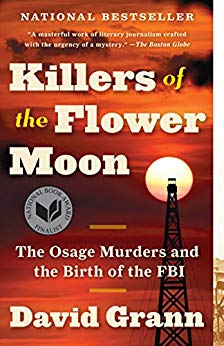

This article is an excerpt from the Shortform summary of "Killers of the Flower Moon" by David Grann. Shortform has the world's best summaries of books you should be reading.
Like this article? Sign up for a free trial here .
Who was Tom White? What role did he play in the Osage investigations?
Tom White, FBI agent, was the Bureau’s lead investigator for the Osage murders. A disciplined and determined agent, he brought the murderers to justice and helped solidify the FBI’s position in American law enforcement.
Continue reading to learn more about Tom White and the difference he made.
Tom White’s Background in Law Enforcement
In the summer of 1925, Tom White, FBI, was the special agent in charge of the Bureau’s Houston office. White straddled two worlds. On the one hand, he was an old-style lawman with no formal police training, a former Texas Ranger who had spent most of his career pursuing bandits on horseback throughout the Texas frontier, armed with a six-shooter. With his Stetson hat, he even looked like a caricature of the mythical Western lawman, still known to carry his trusty six-shooter when he was on dangerous assignments with the Bureau.
But on the other hand, despite his rough-and-tumble background, White had a reputation as a restrained, methodical investigator. Even during his days with the Rangers, a force well-known for its shoot-first methods, White had been different. He had discovered that careful observation and a methodical approach were more effective in catching criminals than running around the countryside, guns blazing. White recognized that many of his fellow Rangers were little more than violent criminals with badges and saw that it was a very fine distinction between a good man and a bad one. He knew that it was dangerous for one man to have the unrestrained ability to take a life, even if he was acting with the sanction of the law.
White’s father, Emmett, had been a sheriff in the wild land of Central Texas in the late 19th century. In those days, local sheriffs often were responsible for running the county jail and performing the executions of convicted criminals. White first saw his father hang a man from the gallows in 1894, when he was just an adolescent. The family lived next door to the jail, which held all manner of violent criminals, including murderers, rapists, arsonists, and robbers. Despite this harsh environment, Emmett did what he could to ensure relatively humane treatment of the prisoners in his custody and took a harsh stance toward anyone in the county who attempted to mete out vigilante justice—which, in Texas, often meant lynchings of black people.
Tom White’s FBI career was relatively bloodless, and he prided himself on the fact that he had never killed anyone in the line of duty, a rarity for an officer of his time and place. His approach to law enforcement was more modern and less bloodthirsty than his background would have suggested, and it earned him a strong reputation within the Bureau of Investigation.
Tom White’s FBI Investigation of the Osage Murders
White headed to the Oklahoma City field office in 1925 to lead the Osage investigation. Upon examining the case, he saw patterns in the killings: all were of wealthy Osage or their benefactors, and three (Anna Brown, Rita Smith, and, their mother, Lizzie) were direct blood relatives.
White methodically ruled out many of the suspects up to that point, including Anna’s ex-husband, by corroborating their alibis. One witness, a young Kaw Indian woman, claimed that another woman named Rose Osage had told her that she’d murdered Anna Brown as revenge for attempting to seduce her boyfriend, a man named Joe Allen. According to the Kaw Indian’s signed statement, Rose and Joe had shot Anna in the back of the head and then dragged the body to the ravine where it was discovered.
But this account failed to match the evidence at the crime scene—Anna’s body showed no signs of having been moved. The Kaw woman admitted that she was lying and that she’d been coerced into signing her false statement by a strange white man who’d showed up at her house. Whoever the conspirators were, they were manufacturing evidence to derail the investigation.
The case was bewildering. The methods of killing were varied: some victims were poisoned, others were strangled, and others were shot. This strongly suggested that the murders were the work of more than one killer. And the unreliability of sources, the reluctance of witnesses to come forward, and blatant corruption of local law enforcement officials made pursuing leads a bewildering exercise. It was near-impossible to separate fact from hearsay.
As he studied the probate records, White discovered that many headrights had come into the possession of Mollie Burkhart, married to Ernest Burkhart, nephew of William Hale. Ernest was known to be highly influenced by his domineering uncle. When all of this money came to Mollie, it would be easy for Hale to exercise control of it through his nephew—though it would be even easier if Mollie were to be killed, too.
Tom White: Forgotten Hero
White did at least enjoy an initial career boost from his work on the Osage case. In the fall of 1926, the U.S. Justice Department named him the new warden of the federal prison at Leavenworth, Kansas. Life had come full circle for White, who had grown up in the shadow of the county jail that his father had operated in Texas.
As he had when he was a boy, White and his family lived in housing directly on the prison grounds. He followed in his father’s footsteps as warden—although he was tough and uncompromising on matters of order and discipline, he also would not allow the men in his custody to suffer cruel or inhumane treatment. He was fair-minded with the inmates at Leavenworth and made genuine efforts to improve conditions at the notoriously unsafe prison.
For someone of his background and era, White was progressive in his attitudes towards convicted criminals, seeing in many of them the potential for redemption and rehabilitation. He was personally opposed to capital punishment, although he was occasionally called upon to oversee executions at the prison—just as his father had been.
Shortly after he arrived at Leavenworth, Hale and Ramsey were transferred to the very same penitentiary. White treated them no differently than any other inmates, sometimes even going out of his way to make it easier for Hale’s wife to visit her husband. For his part, Hale never admitted any involvement in the Osage slayings. He was unrepentant throughout his time in prison, even attempting to bribe an appeals court to secure his early release.
In 1931, after five years on the job, White was shot in the arm by a gang of inmates who had managed to break out of Leavenworth. He had tracked the gang to a nearby farm, where they were holding a teenage brother and sister hostage. His intervention saved their lives, though White forever lost the use of his left arm. When the members of the gang were returned to Leavenworth, White ordered his staff not to harm them, still maintaining his preference for order and justice over mindless vengeance.
Despite his ordeal, White still believed that some inmates could be rehabilitated. One convict, Red Rudensky, a safecracker, had initially been recruited to join the escape plot. But Rudensky had refused, having seen that White was a humane and fair-minded warden who had made genuine attempts to help the men of Leavenworth reintegrate into society upon release.
White had taken an interest in Rudensky’s progress, and the inmate didn’t want to jeopardize his chance of rehabilitation with the dangerous escape attempt. Rudensky turned out to be one of the best success stories to come from White’s progressive approach to the penal system—after he was paroled in 1944, he went on to a successful career as an author and businessman. He credited White with helping get his life back on track.
After White retired in 1951 at the age of 70, he tried several times to reestablish contact with Hoover, who rebuffed his former star agent. Hoover had no interest in sharing credit or the public spotlight with White and had no use for the old retired lawman. White was determined not to let the Osage case fade from public memory and wanted to share with the world his part in bringing the conspirators to justice. Spurned by Hoover, he tried his hand at writing memoirs, a project which he began in 1958.
To assist with this project, he asked Hoover if the FBI would be willing to release old files from the Osage case. But the FBI provided only the most perfunctory materials, and the now-elderly and frail White was left largely on his own to work on the memoirs. Sadly, his work was rejected by the publisher. White passed away in 1971, an obscure and largely forgotten figure, despite his extraordinary efforts in bringing down one of the most infamous criminal conspiracies to terrorize Americans in the early 20th century.
White was one of the most prolific investigators in history—even if no one remembered his name. Through determination, tactics, and careful investigation, White was able to bring the murderers and conspirators to justice.

———End of Preview———
Like what you just read? Read the rest of the world's best summary of David Grann's "Killers of the Flower Moon" at Shortform .
Here's what you'll find in our full Killers of the Flower Moon summary :
- How the Osage tribe had vast oil wealth, but had it seized by their murderous neighbors
- The brutal and unresolved murders of Osage Native Americans
- The complicated history of the FBI in profiting from the Osage murders






